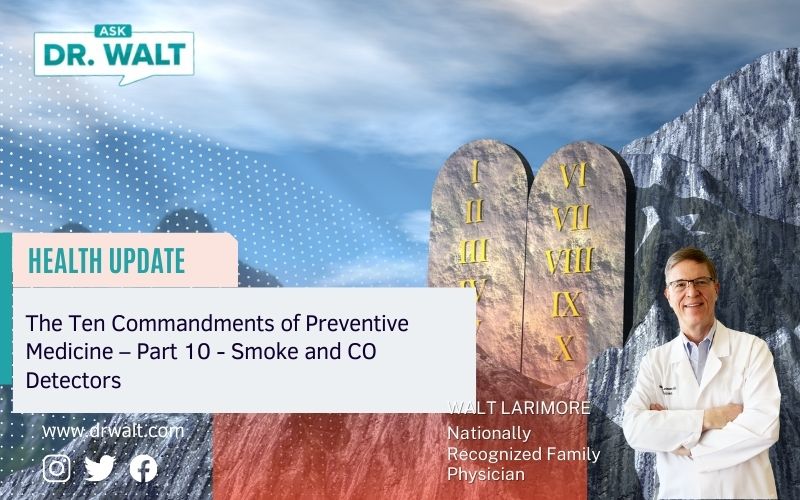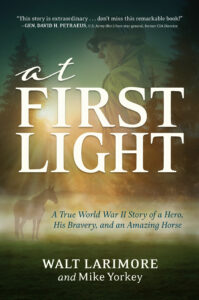
The Ten Commandments of Preventive Medicine – Part 10 – Smoke and CO Detectors
January 15, 2023
Goodbye “Medical News You Can Use”
January 24, 2023After having written over forty books, I’ve been pleased with and have suffered through countless reviews from professional reviewers and readers. Fortunately, most have been very good, affirming, a blessing. But I just received perhaps the best and most uplifting book review I’ve ever received.
The review was on my and Mike Yorkey’s WWII book, At First Light: A True World War II Story of a Hero, His Bravery, and an Amazing Horse, and was published in The Epoch Times – a newer national newspaper – on January 13. See what you think.

Book Review: ‘At First Light: A True World War II Story of a Hero, His Bravery, and an Amazing Horse’
An inspiring true story that reads like historical fiction
DUSTIN BASS – JANUARY 13, 2023 – The Epoch Times
Walt Larimore and Mike Yorkey have written a masterful retelling of a heroic life. “At First Light: A True World War II Story of a Hero, His Bravery, and an Amazing Horse” is a full story. I mean this is in the complimentary sense that it is a story of a courageous life such as one would typically find in fictionalized heroes. Indeed, there were several times I had to reconfirm whether the story was fictionalized, or cleverly and overly embellished. But the authors of the book set the record in stone at the end with a hefty collection of news clippings, photographs, and letters, along with a thorough bibliography.
The story is about Philip Larimore, the primary author’s father, who turned out to be (even to the surprise of his son) one of the most decorated infantrymen of World War II. As the author mentions in the epilogue, his father never talked about the war, which led him to wonder if his father had seen any action at all. Indeed he had—and earned three Purple Hearts (he refused three others), two Bronze Stars, two Silver Stars, and the Distinguished Service Cross.
Creative License for a Working Narrative
Larimore and Yorkey prove their literary mettle by creating believable dialogue throughout the book, whether during battle scenes or romantic sequences. In the introductory “Note to the Reader,” Larimore admits to using creative license while compiling Philip’s life into a working narrative. I was concerned that the writing may suffer, as writers often try so hard to make a true story believable or an actual character relatable that they miss the mark. But as I made my way through, chapter after chapter, I found that the marks consistently hit.
For a biography, there are times where the violence of the fighting is embellished, like when Phil shoots a German in battle; but that isn’t to say the retelling of the situational carnage is not accurate.
Love, War, and Horses
“At First Light” follows the young soldier as he rises through the ranks by his wit, resolve, courage, and tactical understanding. As he marches through Europe with the 3rd Infantry Division, the reader marches on with him, meeting various officers, fighting countless battles, enduring incredible hardships, and writing and reading letters to and from home. Concerning the latter, the thematic element of love during wartime is a literary device used exceptionally well in this book. The timing and usage of specific love letters creates an air of suspense (a suspense obviously different from the battles), and these letters prove both uplifting and wounding.
Philip’s love of and experience with horses play a pivotal role in the book. For this reason, among others, “At First Light” seems like historical fiction. The pieces of the story, both tragic and triumphant, fall seamlessly into place, but this is less a credit to good writing (though that credit is well-deserved and given) than it is to good research.
The authors tie in several themes―love, war and horses―throughout the book. They introduce Philip’s love of horses early on, which remains a connecting point throughout the book. The fact that horses play a significant role makes this nonfiction war story different from so many others. And that role is significant for several reasons. It is a theme woven throughout, but it also gives the reader a glimpse into the heart and personality of the book’s subject.
A Finely Tuned Read
As aforementioned, “At First Light” is a finely written and well-researched book. Larimore’s tireless efforts over the course of years have culminated into a beautifully told story.
Lairmore(sic) notes that his research enabled him to bridge gaps in his father’s story, while at the same time confirming the stories he had been told and the topics he had read in his father’s letters. One may be able to bend reality in dialogue or emotional reactions, but you can’t bend the facts, especially when it deals with wartime actions or engaging with the country’s highest authorities, including Gen. Dwight D. Eisenhower and President Harry S. Truman (both of whom Philip spent time with).
“At First Light” is an inspiring read, not just because it is about a soldier who fought bravely, but also because of the subject’s ability to persevere through loss (love and comrades), injuries (he was wounded six times and lost his leg a month before the war ended in Europe), and rejection (the Army Retiring Board’s refusal to maintain a disabled soldier on staff).
It is a fast read and full story which honors the men and women who served their country and each other. Larimore and Yorkey’s book is a highly recommended read for more reasons than one can pinpoint in a book review.
What an affirmation, encouragement, and blessing it was for Mike and me. If you’d like to learn more about the book or obtain a print, e-book, or audio version of the book, just click here.
CLICK HERE TO LEARN MORE OR ORDER A COPY
© Copyright WLL, INC. 2023.





